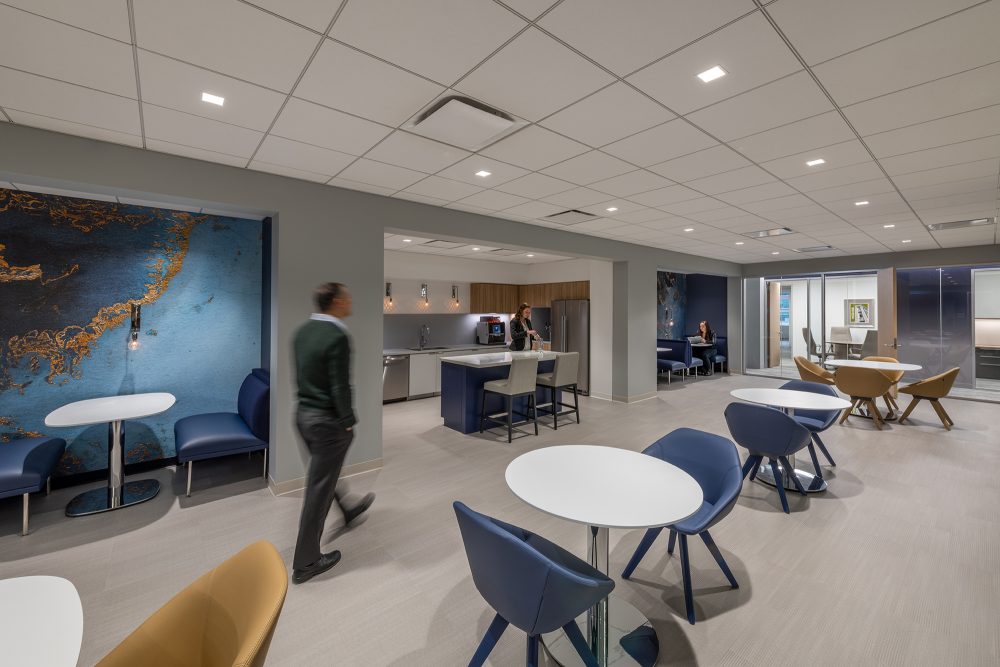Equitable design supports remote and in-person work alike, driving a sense of belonging not only through COVID-19 and beyond.

Work-from-home life may have become the new norm, but 2020 is creating fresh opportunities for companies to support their teams back inside the office, too. After all, despite more people having discovered the benefits of remote work, knowledge workers still solve problems best when they’re together. Plus, many people are missing the sense of belonging that comes with in-person interaction.
It’s going to take more than spacing out desks and doling out hand sanitizer to help employees feel safe and connected back at work. Recent research out of the Wellbeing Lab and George Mason University found that only 21.6 percent of workers in the U.S. feel positive about heading back to their offices, citing COVID-19 concerns, as well as appreciation for the flexibility of working from home.
To re-engage workers in the physical workplace, companies should meet people where they’re at – whether employees are itching for in-person work, worrying over the health risks of that notion, or are somewhere in between. Creative and responsive design solutions can help instill a sense of security and belonging for all employees now, wherever they may be working. Ultimately, effective design strategies can help bridge the gap between the home office and the anchoring workplace, supporting a more vibrant, connected office culture as well as financial goals.
Now is the time to take stock of short-term needs, and also step back and reflect on how your company’s office locations could better serve its teams – and ultimately, its business goals – in the long term.
Equitable design principles for culture, connectedness and cost-savings
The short-term requirements for businesses are clearly to meet health and wellness priorities instigated by a pandemic-changed world. This includes strategies like spacing out desks, setting up dividers, rearranging furniture and designating outdoor gathering areas to help ease employee anxiety about returning to the office.
Looking further ahead, this break in “business as usual” presents a meaningful chance to improve how your office supports your organization as a whole. If your firm is currently planning a build-out to address short-term needs, you may be able to add value by integrating more enduring solutions, too.
Following are five design strategies to help shape positive, equitable design experiences for your teams in the long-term:
1) Create collaborative, safe spaces within your anchor workplace.
Hybrid work may be the new remote work, so adding in more flexible and collaborative spaces in the anchor office may be purely practical in terms of using space more efficiently. This could also include more robust video conferencing rooms, which may have been a luxury in the past, but are rapidly becoming a productivity must-have for many organizations. Designed wisely and with safety measures in place, updated spaces can inspire greater engagement and collaboration with colleagues working in the new hybrid and flexible location paradigm.
2) Take a fresh look at your space requirements.
There’s even less of a one-size-fits-all convention of optimal space utilization than before. Flexible work models are here to stay, so for many firms, less space will do. That said, keeping an office size as-is or even expanding it could support more social distancing and collaboration goals. To create a destination workplace where all your employees feel supported and productive, focus less on prior size standard benchmarks and more on how you use space to support business objectives. And when you bring in workplace strategy consultants, make sure they are not biased toward recommending larger spaces; instead seek counsel you can trust will support your financial and operational needs.
3) Emphasize access and equity early and often in the design process.
Amidst the stress and uncertainty of a global pandemic, it’s more valuable than ever for businesses to show they value all their employees. That begins with understanding not just where your employees work, but how they experience the workplace as they move through it. For example, you might open up the perimeter to make natural light accessible to everyone, and remove space standards that create haves and have-nots. Or, you might choose furniture and fixtures that are comfortable and welcoming for everyone, such as using resilient materials in a communal lounge where field employees might otherwise feel unwelcome. The first step is to review your build-out to ensure you are considering comfort and amenities equally for team members of all backgrounds, genders and job levels.
4) Reinforce your values, on your budget.
There are many resourceful ways to help improve the employee experience in the office on any budget. The key is to look for design partners who will understand your brand culture and values and will offer creative solutions to bring them to life for your firm. For instance, if your organization is a nonprofit or not-for-profit, you may need a space that is pleasant and inviting for employees, while also being and appearing fiscally responsible. Elevating standard materials can help the space look and feel nice, while extending the impact of a fiscally responsible budget.
5) Create enticing third spaces.
Many employees appreciate the flexibility that’s been afforded by months of working from home. Yet it’s also safe to say many are also eager to get back to a more dynamic setting than their own home office (or kitchen table). Having other spaces to go in the anchor workplace, whether it’s a lobby café, modern conference room, collaborative work commons or casual terrace will become even more compelling than ever.
Destination workplace design supports all employees
Aesthetics add to an experience, but effective corporate design is about more than just skillful decorating. By understanding how a space will function, flow and ultimately serve your organization, you can shape safe, engaging destinations for your whole team.
No one can know for certain how long the pandemic will last. But one thing we can be sure of is the lasting value of equitable design in the workplace.

